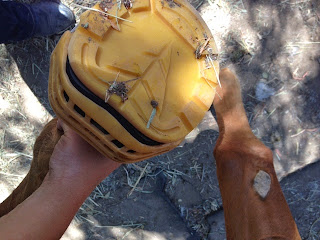Most of you know I already purchased an Endurance saddle, which was the major purchase I was avoiding. Now I've had the major battle between purchasing English tack, Western tack, and Endurance tack! My heart goes to English tack, it's so beautiful and takes me back to what I deemed pretty in my childhood.
This is a typical hunter class, braided mane and tail, polished, clean, minimalistic. The rider's outfit is gorgeous, the horse looks classy all cleaned up, and their tack is understated. While this tack is gorgeous, it's not comfortable on the trail in any way!
That leaves me with endurance tack or western tack. Endurance tack is nice because it isn't leather, meaning you don't have to soap and condition the bridle once it's dirty, just wash and wear! Endurance tack is great for trail, but not for training. I'm sure others will disagree, but since Calvin is so young, I have to train him from ground zero, which means I do need to utilize an arena. Endurance bridles have all these clips for quick changes like switching out the bit and reins. The downside to clips is that they make noise and you can't get a really nice feel on the reins for training because of the constant clacking. Also, I'm not doing very long distances to really need that bridle and be able to justify the price.
This narrowed it down to western tack. I never, in a million years, thought I'd be buying western tack...but here I am! I purchased a "headstall" (aka bridle in english riding terms) and lead-rope reins.
I ride Calvin bitless when we are by ourselves on trail only, but when I want him to do more advanced work the bit is a necessity. Without the bit, I have to pull so hard on his nose and it causes rub marks because he doesn't always want to listen. With a bit, I only need slight rein contact for him to listen nicely. Also, he tends to freak out when we are on trail with other horses, so the bit helps me redirect him in a kinder way than yanking on his face in a halter.
I didn't like the snaffle bits that western folks use, so I bought an english snaffle. I liked my rubber bit, but it is really too big inside Calvin's mouth and he can't really close it properly, much less drink or eat with it in. The old school of thought was a thick bit=a softer bit, but research has shown this isn't true. In fact, horses have smaller mouths than previously thought, so narrower, properly fitting bits are actually softer. This new bit I purchased has been scientifically proven (source) to be comfy for horses and is a really soft bit, despite it being metal! The metal is a copper, silicon, zinc alloy which promotes salivation in horses, making it a comfy bit. Also, it's called a "french link"meaning there is a bean in the middle which prevents the two sides from jabbing up into his soft pallet. This short video also gives a good description of why they are soft bits. I've tried it twice with Calvin and he responds to it very nicely. He acts the same as he did in the rubber bit, so that means it's not too harsh. This Herm Sprenger bit retails for $140, but I found it on ebay for $60!
I actually bought a bradoon by accident, but it works the same as a loose ring so no harm done. Bradoons are used in dressage for a double bridle hence why the rings are smaller. In a typical loose ring, the side rings are larger in diameter, but this is the only difference between the two. This bit came in a smaller 14mm mouthpiece which actually fits in his mouth better than the 16mm that the loose ring comes in.
My final purchase was a new helmet! You're supposed to replace helmets every 5 years, I've had my last one for 15 years (oops!). I'd still be using it too, but it is just too big and hot for trail riding. This one is called a Tipperary Sportage 8500. It's lightweight and has lots of air vents. I got it in the navy blue, I'm over black helmets, they're too hot. Also, this came in at $60, a huge savings over the old hunter-jumper helmets which run for $350+. I don't know how people can afford to replace them every 5 years at that rate.
Tipperary helmet in blue. Germy is also excited!
















